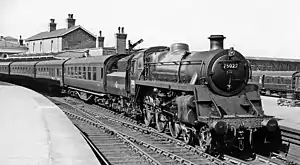BR Standard Class 4 4-6-0
The British Railways Standard Class 4 4-6-0 is a class of steam locomotives, 80 of which were built during the 1950s. Six have been preserved.
| BR Standard Class 4 4-6-0 | |||||||||||||||||||||||||||||||||||||||||||||||||||||||
|---|---|---|---|---|---|---|---|---|---|---|---|---|---|---|---|---|---|---|---|---|---|---|---|---|---|---|---|---|---|---|---|---|---|---|---|---|---|---|---|---|---|---|---|---|---|---|---|---|---|---|---|---|---|---|---|
 75022 at Gloucester Eastgate in April 1959. | |||||||||||||||||||||||||||||||||||||||||||||||||||||||
| |||||||||||||||||||||||||||||||||||||||||||||||||||||||
| |||||||||||||||||||||||||||||||||||||||||||||||||||||||
| |||||||||||||||||||||||||||||||||||||||||||||||||||||||
| |||||||||||||||||||||||||||||||||||||||||||||||||||||||
Background
.jpg.webp)
The class was introduced in 1951. They were designed for mixed traffic use on secondary routes where the otherwise ubiquitous BR standard class 5 and their predecessors, the Black Fives, would be too heavy. They were essentially a tender version of the standard 4 2-6-4T, with similar characteristics to the GWR Manor Class, though unlike the Manors they were built to the universal loading gauge. They used the same running gear as the tank engine (with the leading bogie from the Standard Class 5), and substantially the same firebox, smokebox and boiler, although the boiler barrel was increased in length by 9 inches (229 mm).[1]
Design work was done at Brighton by R. A. Riddles, with help from Swindon, Derby and Doncaster. Construction was at the BR Swindon Works.
The engine weighed 67.90 long tons (68.99 t; 76.05 short tons), was 60 ft 0 in (18.29 m) long, with 5 ft 8 in (1.727 m) diameter driving wheels. It had two cylinders of 18 inches (457 mm) diameter and 28 inches (711 mm) stroke operated at maximum boiler pressure of 225 lbf/in2 (1.55 MPa), to produce 25,515 lbf (113.5 kN) tractive effort. Its British Railways power classification was 4MT.
It normally used the standard BR2 or BR2A tender, which weighed 42.15 long tons (42.83 t; 47.21 short tons) and carried 3,500 imp gal (16,000 l; 4,200 US gal) of water and 6.00 long tons (6.10 t; 6.72 short tons) of coal. In this configuration its route availability was 4, almost universal over the British Railways network.
In service
The class was initially allocated to the London Midland Region (45) and the Western Region (20). The last 15 were allocated to the Southern Region. The Southern batch were built with BR1B tenders, which weighed 49.15 long tons (49.94 t; 55.05 short tons), and carried 4,725 imp gal (21,480 l; 5,674 US gal) of water and 7.00 long tons (7.11 t; 7.84 short tons) of coal. This reduced their route availability to 7, the same as the Standard Class 5.
| Year | Quantity in service at start of year | Quantity withdrawn | Locomotive numbers | Notes |
|---|---|---|---|---|
| 1964 | 80 | 2 | 75001/67 | |
| 1965 | 78 | 11 | 75000/03/05/07–08/22/25/28/38/72–73 | |
| 1966 | 67 | 20 | 75011/14/23/31/36/44–45/49–51/53–54/56–57/63/65–66/69–70/79 | |
| 1967 | 47 | 37 | 75002/04/06/10/12–13/15–18/24/26/29–30/33/35/37/39–40/42–43/46–47/52/55/58–61/64/68/71/74–78 | |
| 1968 | 10 | 10 | 75009/19–21/27/32/34/41/48/62 | |
Preservation
Six members of the class have survived into preservation. Two members of the class were purchased directly from BR for preservation (75027 & 75029); the remaining four engines were rescued from Woodham Brothers' scrapyard at Barry Island.
No member of the class is presently main line approved but three of them (75014, 75029 and 75069) have worked on the main line at various points in preservation. 75029 was passed to work on the main line between Grosmont and Whitby with occasional visits to Battersby during galas. 75027 has been cosmetically restored for display as part of the Bluebell Railway's 'Steamworks!' exhibition.
| Number & Name | Tender Attached | Built | Withdrawn | Service life | Location | Livery | Status | Image |
|---|---|---|---|---|---|---|---|---|
| 75014 "Braveheart" | BR2A | Nov 1951 | Dec 1966 | 15 years, 30 days | Dartmouth Steam Railway | BR Lined Black, Early Emblem | Operational |  |
| 75027 | BR2A | May 1954 | Aug 1968 | 14 years, 3 months | Bluebell Railway | BR Lined Green, Late Crest | Static Display awaiting overhaul |  |
| 75029 "The Green Knight" | BR2A | May 1954 | Aug 1967 | 13 years, 3 months | North Yorkshire Moors Railway | BR Lined Green, Late Crest | Under Overhaul | .jpg.webp) |
| 75069 | BR1B | Sept 1955 | Sept 1966 | 11 years | Severn Valley Railway | BR Lined Black, Late Crest | Operational |  |
| 75078 | BR1B | Jan 1956 | Jul 1966 | 10 years, 5 months | Keighley and Worth Valley Railway | BR Lined Black, Late Crest | Operational |  |
| 75079 | BR1B | Jan 1956 | Nov 1966 | 10 years, 10 months | Mid-Hants Railway | N/A | Undergoing restoration. |  |
Modelling
Bachmann and Hornby have both recently released models of these engines in 00 gauge. Mainline also released a model of the Standard Class 4MT 4-6-0 in the 1970s, although this is no longer in production.
References
- Casserley, H.C. (1960). The Observer's Book of Railway Locomotives of Britain. London: Frederick Warne & Co. Ltd. p. 226.
External links
| Wikimedia Commons has media related to BR Standard Class 4 4-6-0. |